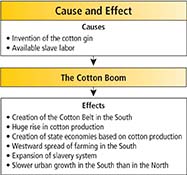CHAPTER 7: Quick Study Guide
Progress Monitoring Online
For: Self-test with vocabulary practice
Web Code: nca-0711
- Key Inventions and Innovations
Invention or Innovation Political, Economic, or Social Effect(s) Toll roads Expanded transportation routes Steamboats Allowed faster travel, shipping, and upstream movement Canals Expanded transportation routes; improved commerce by linking farms to cities; opened new regions to settlement Railroads Cost less to build than canals and could move farther and faster, and carry more weight; connected East and West Textile mills Provided jobs; increased the speed of producing textiles Interchangeable parts Made possible the efficient production of a wide range of manufactured goods - Causes and Effects of the Cotton Boom
- Key Nationalist Supreme Court Cases
Case Issues Outcome of Decision McCulloch v. Maryland (1819) - Does the government have the power to create a national bank?
- Do states have the right to tax institutions created by the federal government?
- Reinforced the principle of the power of the national government over state governments; states could not interfere with an agency of the national government and, therefore, could not tax the national bank
Gibbons v. Ogden (1824) - Who has the power to regulate commerce: the states, the federal government, or both?
- What if states passed laws that affected business between states?
- Established the federal government’s right to regulate all aspects of interstate commerce
 Quick Study Timeline
Quick Study Timeline
For: Interactive timeline
Web Code: ncp-0713






